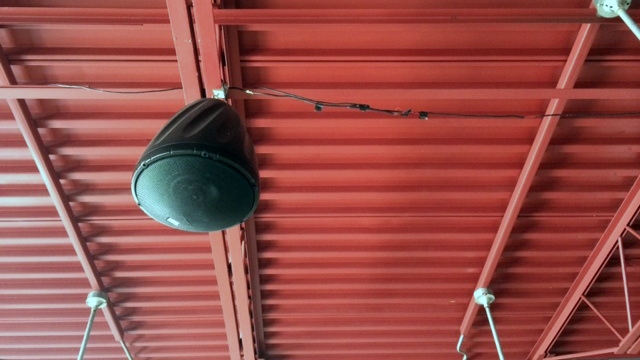“Attention K-Mart Shoppers” crackling over loudspeakers next to a big, flashing blue light. That may be a relic of a bygone era, but the power of in-store audio messaging at the point of purchase is as great as ever. And today, the ability to implement overhead messaging is more accessible – even for small businesses – than ever before.
Audio ads are everywhere. On our favorite radio stations, on the podcasts we listen to, on free Pandora or Spotify accounts, and even public radio. Why? Because audio ads work and advertisers understand how audio messages can be used to drive sales and build brand awareness.
The key to an audio message’s effectiveness is how well targeted it is. In other words, how well is the advertisement or promotion being heard by the right “buying” audience. A marketer probably wouldn’t run ads for a nursing home on a top 40 music station. Nor play ads for a Kayne West concert on a golden oldies radio station. That’s why advertisers are increasing using demographic data, AI and market research to fine tune their ad placements on digital and traditional media.
The audience you’re looking for is right in front of you – your customers.
But if you run a business, you don’t need to have an expensive, data-driven marketing strategy to reach the right target audience. You have invested in great, licensed music for your business. Now you can add between-the-songs promotion messages to help drive sales, inform customers and reinforce your brand images.
You likely already use a variety of visual on-premise marketing tools like printed materials, signage, fliers and digital video displays. Visual displays are effective, but they are limited to your customer’s proximity and attention span. Leveraging your audio space can be as or more effective than visual alone:
- You have a captive, listening audience. Every person in your store, office or restaurant at any given time is part of a targeted, point of purchase listening audience.
- The Audio Space is a powerful communication tool. Whether it’s only music, or a combination of music and messaging, what’s playing in your store telegraphs your brand’s image, attitude, style and energy.
- The Audio Space is immersive. Like aromas and light, it’s experienced by everyone no matter where they are in the store or what they are doing.
- The Audio Space is both active and passive. Music, messages and store branding are present whether shoppers are actively listening or not. For example, we know from research that radio commercials “sink in” even if listeners tell us they don’t pay attention to commercials.
- The power of Audio Space must be respected. If what’s heard in the Audio Space (music, messaging, branding) is wrong, you’re communicating the wrong message about your brand. And, using a very powerful medium to do it.
- The right audio entertainment carries your message further. Your unique mix of custom music playlists and on-brand ads is designed to be more active and engaging than any pre-programmed music service ever could be. It’s designed to take full advantage of the power of the audio space.
Remember, your Audio Space is a valuable asset, one that gives you the ability to communicate with your customers or patients right at the point of purchase.
What’s Your Message?
Many businesses discovered the power and necessity of between-the-songs messaging as they reopened operations following COVID-19 mandated shut-downs in the spring and summer of 2020. Retail stores, restaurants, dental offices and more used audio messaging to remind customers and employees of the precautions the business is taking to ensure the safety of customers and staff and for the need to maintain social distancing, mask-wearing, etc.
But beyond this solely practical use of audio messaging, business have discovered they can use messaging for fun and profit:
- Direct customers to your current special offers and sale items.
- “Upsell” by suggesting additional services or products to your customers.
- Create fun “shout outs” featuring your staff and welcoming customers.
- Sell in-store advertising to your suppliers to promote their products in your store.
- Be timely and relevant with seasonal or holiday themed messages (4th of July, Christmas, Valentine’s Day, Cinco de Mayo, etc.).
- Promote your company’s brand image, values, mission and community involvement.
- Remind customers of your social media, website, emails and other forms of digital engagement.
Audio Messaging Pro Tips
- Use services designed to implement messaging. Custom Channels’ ReMix or Ethos services play messages between the songs and DON’T interrupt the music mid-song.
- Create messages yourself using common computer-based software and a microphone or mobile device app. However, many businesses find it is best to outsource audio messages to professional voice talent. Custom Channels provides optional voice services with our professionals. Also, you can find many resources for voice talent online through sites like Voice123 or Fiverr.com
- Try to keep multiple messages in rotation at the same time. That way, you’re not hearing the same thing over and over every hour.
- Schedule your audio messages so they are heard at least once during a typical customer visit.
- Update your messages with a fresh voice or new copy at least every few months so they don’t get stale and boring.
- Write your seasonal messages so they can be reused next year!
At Custom Channels, we have decades of experience using the power of audio messaging to drive sales and influence customer behavior and perceptions. Read more about our messaging services here. Or, better yet contact us and get a free consultation from one of our in-store music and messaging experts.

